
Wine Culture and Information since 2002 - Volume 22
 Wine Culture and Information since 2002 - Volume 22 |
|
Issue 151, May 2016 |
Contents |
|
|
The Wine of the Young |
|
I am not going to talk about the consumption of wine in young people and their relation with the beverage of Bacchus, alcohol and the social consequences of this behavior, in particular when it is about deplorable abuse and excess. I am going to talk about those young who have with wine a very different relation with wine, those who do not simply appreciate it in a glass - with a better and conscious respect - and, in particular, they took it from the vineyard to the bottle. I am going to talk about young wine producers. In the past recent years, more and more young people are committed to agriculture, not only because they have a passion for it, but also because they have to. In these times, not really good even for those who have the good will of doing, young people, as they are not successful in getting a job in the industry or tertiary sector, are getting a job in agriculture. Instead of working for just few months per year - with quite low wages and certainly not enough to ensure a decent lifestyle - young people start a farm business and make the decision of taking their fruits from the land. Of course it is about very hard work, away from the easiness of office's chairs, however giving the benefit of being free in the middle of nature and getting satisfaction from one's own efforts. However, it is not about the very hard work of farmers of the past, some tens of years ago: today technology and progress, luckily, make this job easier. New farmers and vintners have a different approach than the ones of the past: they study, work with a better consciousness, without forgetting the experience of those who preceded them. They consider tradition but with the awareness technology and progress offer a benefit to this job. On this regard, we should notice what we consider today as “tradition” was just a successful innovation of the past. This means it is always good to consider the past, however it is important as well to look ahead to the future and let the evolution progress. After all, in case man would have been faithful to the tradition of the past without considering the future, human beings would still be living the paleolithic era. There also are young people who make the decision of continuing the job of their fathers, which was sometimes the one of their grandfathers and great-grandfathers as well. Indeed, they carry it on by adding their “young” knowledge and vision, sometimes introducing modern technologies, without forgetting about the history of their families. As opposed to past generations, young people have the chance to study and graduate in matters related to agriculture and viticulture, they bring their “new knowledge” to the knowledge of their fathers. Their contribution does not however deny the family style, at least in general terms. Indeed, most of the times their job can be compared to that of their fathers, sometimes even better. We should be very happy for this - or, at least, I am - by praising their good will and commitment, as well as for perpetuating a priceless heritage to future generations. After all, this exactly was what their fathers, grandfathers, great-grandfathers and ancestors did. In recent years, when I happen to visit wineries or attend to wine fairs, I see more and more sons and daughters of producers working with their parents in vineyards and wineries. They are introduced, and with a lot of understandable pride, as the natural evolution of the family story looking ahead to the future. For parents, with no doubt, there is the satisfaction of knowing the effort of their job and of those who preceded them can go on, hopefully improved by new ideas and talents. They teach their children, in a sense, by holding their hands and by making them aware of the family style, knowing that - sooner or later - they will be the ones who will keep and perpetuate the knowledge of their fathers. It is not about a simple and natural law, indeed it is a necessary choice of evolution as new generations better understand what modern times are demanding, as they are sons and daughters of a new era. What they do is to adapt and perpetuate the job of their fathers to the future, by exactly doing what has been done by those who preceded them. The wines they make follow, in general terms, the family style, to which is added, something easily understandable, part of their character, by working side by side with their parents who usually play the important role of “guide”. In certain cases the revolutionary ideas they introduce to the family style are such that they completely change the sense of a story, it seems they want to break the bond with the past, it seems like it is a burden to carry on and to get rid of. I admit it is sometimes hard for me to understand their “revolutions” and, although it can be praised because of their will, I am puzzled about the result, most of the times following a fad instead of a concrete wine making knowledge. I am used to say all the time, what I do not understand does not mean it is wrong, it simply is something not meeting my taste or vision about wine. It can also be they are right - and this can of course be case - and their vision about wine is more evolved than mine. I admit it sometimes seems to me sensational backward steps to the wine model that, when I started working on the beverage of Bacchus, were considered as coarse wine making models everyone wanted to get rid of. The most important thing, however and no matter what I think or appreciate, is that young people - and they are many - are interested in making wine. No matter the reason or model they passionately follow with strong determination, the most important thing is they do that. Another highly appreciated thing, is the rebirth of a new conscience about the respect for the environment and sustainability. In a world which seems to get smaller and smaller, however needing to ensure a place for everyone - as everyone has the same dignity and right - this is a praiseworthy challenge for young farmers and viticulturists. Good job boys: I wish myself and yourselves your passion may always drive your ideas and carry them on to a successful end. A revolution can also be started from a glass of wine, even in case I do not understand it. On the contrary, you probably understand it and this is what really counts. Antonello Biancalana
|
||||
Contrasts of Garganega and VermentinoTwo great white grapes protagonists of wines among the most representative ones of Italy, with different characters however expressions of great personality |
|
The number of autochthonous wine grapes of Italy has no equal in any other country of the world. The enological beauty of Bel Paese is also expressed by this particular characteristic allowing every region of Italy to have at least one indigenous variety. An invaluable richness allowing this country to offer a remarkable number of wines, different territorial expressions in which each grape can offer a unique character. Of course this does not mean each autochthonous grape is capable of making quality wines - and the same is true for territories - it is however true this characteristic makes Italy a unique wine land of the world. It is not by chance, in fact, when ancient Greeks arrived to these lands, they called Italy Enotria Tellus. Land of wine but also of grapes - many grapes - already present and common at the times of Magna Graecia. Ancient Greeks, it should be said, introduced many grapes to the lands which will then become Italy, and the influence of Hellenic people in wine making and viticulture of this country is still today evident in the names of many grapes. The grapes of our tasting by contrast of this month are very important representatives of the huge heritage of Italian autochthonous varieties: Garganega and Vermentino. The former variety - Garganega - is the grape which undeniably marked the rebirth of one of the most famous Italian white wines: Soave. Vermentinno is the protagonist of many white wines of Sardinia, however it also plays an important role in Liguria and Tuscany. The presence of these grapes is also found in other regions of Italy - although marginally - whereas Vermentino is also cultivated in France and Corse. Garganega is the most important white berried grape of Verona and Vicenza provinces, the main grape of Soave and Gambellara wines. In particular, in Soave territory, Garganega is responsible of the rebirth of white wines of this area, giving them a better personality, elegance and finesse. The origins of Garganega are not clear, however it is believed its presence in this land is evidently dated back to remote times, as well as believing it was introduced to this territory by Etruscans. Pietro de' Crescenzi, the famous writer and agronomist of the 1200s, mentioned Garganega in his book and, even at those times, this grape was praised for the production of sweet wines. On this regard, it is believed Garganega was used by Rhaetian people for the making of their sweet wines, also mentioned by Pliny the Elder, whom, among the many things, supported the idea Rhaetian people were of Etruscan origins. Garganega is still today one of the most prestigious grapes and having a good versatility, protagonist of white and sweet wines of remarkable elegance. The famous white berried grape of Veneto is the main variety of Soave and Recioto di Soave, and today it is the main grape used for these wines, most of the times it is the only one. With time, Garganega has in fact replaced the other varieties provided for the production of these wines, in particular Trebbiano di Soave, and today most producers tends to use it alone. The same can be said for Gambellara wines, in which Garganega is used alone both for dry and sweet wines of the territory. This grape is mainly found in Veneto, however it is also marginally found in other regions of Italy, such as Umbria and Lombardy. The best expression of Garganega is however found in the provinces of Verona and Vicenza, both for white wines and sweet wines produced with dried grapes. The origins of Vermentino seem to be clearer. The origin of this great white variety is to be found in Spain, more likely in Portugal, it was then introduced to the lands of France, therefore to the Italian territory. Vermentino is particularly common in Sardinia, introduced here from the neighboring Corse, and it is today the most common white berried grape of the island. From Sardinia Vermentino has been then spread to Liguria and therefore Tuscany, regions in which this white grape is still today widely common. Moreover, it is believed some autochthonous varieties, such as Pigato, Rollo and Favorita, are indeed similar to Vermentino and, therefore, it is the same grape. The same consideration is true for the so called Vermentino di Gallura and Vermentino di Alghero, both cultivated in Sardinia and both representing the same variety.
Vermentino expresses different characters in the three lands in which it is mainly found: Sardinia, Liguria and Tuscany. In Sardinia Vermentino generally makes wines of good body and complexity, whereas in Liguria gives wines of more refined elegance of aromas and a weaker body. In Tuscany Vermentino seems to express quite different characters, while keeping both elegance of aromas and good body. Sardinia is today considered the main land of Vermentino and wines produced with this grape are recognized as Denominazione d'Origine Controllata in the whole territory of the island. The most prestigious expression certainly is Vermentino di Gallura - recognized as DOCG (Denominazione d'Origine Controllata e Garantita) - having a pretty strong personality while expressing good elegance. Vermentino is however a versatile grape, in particular in Sardinia where it is used for the production of sparkling and dry wines, as well as sweet wines from dried grapes. The wines of our tasting by contrast will be chosen from the areas of Soave, in Veneto, and Gallura, in Sardinia. Specifically, as for Garganega, we will choose a Soave Superiore, whereas for the other variety our choice will be about a Vermentino di Gallura. In both cases, we should consider the respective production disciplinary provides for the use of different varieties of the territory, it is therefore indispensable our wines will be made with 100% of the respective grapes. This is particularly important for Soave Superiore, as production disciplinary provides for a minimum Garganega of 70%. We will choose wines belonging to the latest vintage as we need young wines capable of expressing the character of the respective grapes. Production technique is important as well, we therefore make sure both wines are produced in steel tanks. The samples of our tasting will be served at the temperature of 10 °C (50 °F) and poured in tasting glasses. Let's pour both wines in glasses and start the evaluation of appearance from Vermentino di Gallura. Let's tilt the glass over a white surface - for this purpose is enough a simple sheet of paper - and observe the wine at the base of the glass. It will be observed an intense and brilliant straw yellow color and a very high transparency, something easily predictable. We will not in fact have any problem in recognizing the details of an object put between the glass and the white surface. Nuances of color, observed at the edge of the wine towards the opening of the glass, shows a greenish yellow hue. Let's now observe the appearance of Garganega expressed by Soave Superiore wine. At the base of the glass will be observed an intense straw yellow color, sometimes tending to golden yellow, with a transparency - also in this case - very high. Nuances of Garganega confirm its color, showing a straw yellow hue tending to golden yellow. Aromatic profiles of Garganega and Vermentino have some common characteristics as well as substantial differences, they however give the nose of the taster a character of elegant personality. Both varieties are mainly characterized by their aromas of white pulp fruits, in particular apple and pear. The aromatic profile of Vermentino, in general terms, expresses qualities directly recalling citrus fruits - in particular lemon - with a character, like to say, crisper than Garganega. The white berried grape of Veneto is characterized, among the other things, by a typical aroma of almond, a quality which can be perceived both in its dry and in sweet wines made from dried grapes. In both varieties are found sensations recalling tropical fruits, in particular pineapple, and aromas recalling flowers mainly express hawthorn and broom. Let's now pass to aroma evaluation of the two grapes of our tasting by contrast. We will start from Vermentino di Gallura, by holding the glass in vertical position and without swirling. Let's do our first smell in order to evaluate opening aromas. From the glass will be perceived aromas of apple, pear and hawthorn, intense and well perceptible. Let's now swirl the glass - in order to favor the development of the other aromas - and do a second smell. From the glass will be perceived the characteristic aroma of lemon to which follows broom, plum, peach, pineapple and a hint of almond. Let's now pass to the evaluation of Garganega's aromas expressed by Soave Superiore. The opening of this wine gives the nose of the taster aromas of apple, broom and pear, as well as the characteristic almond aroma. After having swirled the glass, the olfactory profile is completed by hawthorn, peach, plum, pineapple and apricot. In Garganega can also be sometimes perceived the aroma of honey. Gustatory qualities of Vermentino and Garganega are characterized by pretty evident differences, in particular structure. Both varieties make wines with a pretty high alcohol by volume - it is not rare to have wines having 13% of alcohol - a characteristic clearly affecting the gustatory profile. In the attack of Vermentino di Gallura can be appreciated an evident crispness, given by acidity, a quality making this wine very agreeable. It will be noticed the contribution of alcohol in the balance of wines, as well as the good correspondence to the nose, in particular apple, pear and pineapple. Let's now take a sip of Soave Superiore. The attack of Garganega is characterized by a rounder crispness than Vermentino and, in general terms, a more robust structure. Also in this wine alcohol plays an evident role in the balance, something also contributing to increase roundness, clearly stronger than Vermentino. Correspondence to the nose is very good and we can perceive apple, pear and peach. Let's finish our tasting by contrast with the evaluation of final sensations the two wines leave in the mouth after having been swallowed. Vermentino and Garganega make wines of interesting characteristics leaving in the mouth sensation of very good quality. The finish of Vermentino di Gallura has good persistence and in the mouth can be perceived - after having swallowed the wine - pleasing and clean flavors of apple, pear, pineapple and lemon. Final sensations left in the mouth by Soave Superiore's Garganega are interesting as well. The persistence of this wine is very good and in the mouth can be perceived flavors of apple, pear, plum and the characteristic bitter hint of almond. As opposed to Vermentino, in Garganega can be perceived the sensation of a more robust structure while crispness given by acidity seems to be lower than Vermentino. Both grapes can certainly be considered excellent, capable of making great white wines, of remarkable personality and quality.
|
||||||||||||
Wines of the Month |
|
|
|
Score legend Prices are to be considered as indicative. Prices may vary according to the country or the shop where wines are bought |
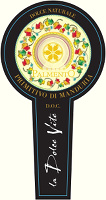
|
|
Primitivo di Manduria Dolce Naturale La Dolce Vite 2011 |
|
| L'Antico Palmento (Apulia, Italy) | |
 Primitivo Primitivo | |
| Price: € 30.00 | Score: |
 Deep ruby red and nuances of garnet red, little transparency. Deep ruby red and nuances of garnet red, little transparency. Intense, clean, pleasing and refined, starts with hints of blackberry,
black cherry and plum followed by aromas of dried violet, blueberry, carob,
tamarind, pink pepper, walnut husk and nail polish. Intense, clean, pleasing and refined, starts with hints of blackberry,
black cherry and plum followed by aromas of dried violet, blueberry, carob,
tamarind, pink pepper, walnut husk and nail polish.
 Sweet and tannic attack, however balanced by alcohol, full body,
intense flavors, pleasing roundness. Sweet and tannic attack, however balanced by alcohol, full body,
intense flavors, pleasing roundness.
 Persistent finish with flavors of blackberry, black cherry and plum. Persistent finish with flavors of blackberry, black cherry and plum. Aged in steel tanks. Aged in steel tanks. |
|
 Jam tarts, Chocolate tarts, Hard and piquant cheese Jam tarts, Chocolate tarts, Hard and piquant cheese |
|
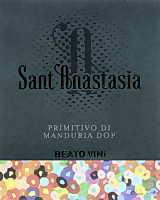
|
|
Primitivo di Manduria Sant'Anastasia 2013 |
|
| Beato Vini (Apulia, Italy) | |
 Primitivo Primitivo | |
| Price: € 22.00 | Score: |
 Intense ruby red and nuances of garnet red, little transparency. Intense ruby red and nuances of garnet red, little transparency. Intense, clean, pleasing and refined, starts with hints of plum jam,
black cherry jam, blackberry jam followed by aromas of dried violet,
tobacco, vanilla, chocolate, mace and menthol. Intense, clean, pleasing and refined, starts with hints of plum jam,
black cherry jam, blackberry jam followed by aromas of dried violet,
tobacco, vanilla, chocolate, mace and menthol.
 Properly tannic attack and however balanced by alcohol, full body,
intense flavors, pleasing roundness. Properly tannic attack and however balanced by alcohol, full body,
intense flavors, pleasing roundness.
 Persistent finish with flavors of plum jam, black cherry jam and
blackberry jam. Persistent finish with flavors of plum jam, black cherry jam and
blackberry jam.
 12 months in barrique. 12 months in barrique. |
|
 Game, Roasted meat, Stewed and braised meat, Hard cheese Game, Roasted meat, Stewed and braised meat, Hard cheese |
|
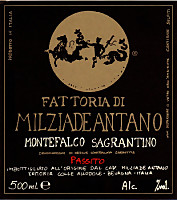
|
|
Montefalco Sagrantino Passito 2011 |
|
| Fattoria Colleallodole - Milziade Antano (Umbria, Italy) | |
 Sagrantino Sagrantino | |
| Price: € 40.00 - 500ml | Score: |
 Deep ruby red and nuances of garnet red, little transparency. Deep ruby red and nuances of garnet red, little transparency. Intense, clean, pleasing, refined and elegant, starts with hints of
blackberry, plum and dried violet followed by aromas of black cherry,
blueberry, vanilla, licorice, chocolate, mace, tobacco, walnut husk and
nail polish. Intense, clean, pleasing, refined and elegant, starts with hints of
blackberry, plum and dried violet followed by aromas of black cherry,
blueberry, vanilla, licorice, chocolate, mace, tobacco, walnut husk and
nail polish.
 Sweet and tannic attack, however balanced by alcohol, full body,
intense flavors, pleasing roundness. Sweet and tannic attack, however balanced by alcohol, full body,
intense flavors, pleasing roundness.
 Persistent finish with flavors of blackberry, plum and black cherry. Persistent finish with flavors of blackberry, plum and black cherry. 18 months in barrique, 6 months in bottle. 18 months in barrique, 6 months in bottle. |
|
 Chocolate tarts, Hard cheese, Jam tarts Chocolate tarts, Hard cheese, Jam tarts |
|
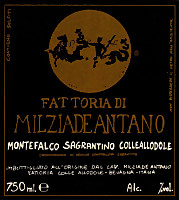
|
|
Montefalco Sagrantino Collepiano 2011 |
|
| Arnaldo Caprai (Umbria, Italy) | |
 Sagrantino Sagrantino | |
| Price: € 75.00 | Score: |
 Intense ruby red and nuances of garnet red, little transparency. Intense ruby red and nuances of garnet red, little transparency. Intense, clean, pleasing, refined and elegant, starts with hints of
blackberry, black cherry and violet followed by aromas of plum, blueberry,
vanilla, tobacco, mace, pink pepper, face powder, chocolate, cinnamon,
leather and menthol. Intense, clean, pleasing, refined and elegant, starts with hints of
blackberry, black cherry and violet followed by aromas of plum, blueberry,
vanilla, tobacco, mace, pink pepper, face powder, chocolate, cinnamon,
leather and menthol.
 Tannic attack and however balanced by alcohol, full body, intense
flavors, agreeable. Tannic attack and however balanced by alcohol, full body, intense
flavors, agreeable.
 Very persistent finish with long flavors of blackberry, plum and black
cherry. Very persistent finish with long flavors of blackberry, plum and black
cherry.
 22 months in barrique, at least 6 months in bottle. 22 months in barrique, at least 6 months in bottle. |
|
 Game, Roasted meat, Braised and stewed meat, Hard cheese Game, Roasted meat, Braised and stewed meat, Hard cheese |
|

|
|
Barolo Gramolere 2011 |
|
| Manzone Giovanni (Piedmont, Italy) | |
 Nebbiolo Nebbiolo | |
| Price: € 36.60 | Score: |
 Brilliant ruby red and nuances of garnet red, moderate transparency. Brilliant ruby red and nuances of garnet red, moderate transparency. Intense, clean, pleasing, refined and elegant, starts with hints of
cherry, plum and violet followed by aromas of raspberry, blueberry,
vanilla, rose, tobacco, chocolate, licorice, mace, leather and menthol. Intense, clean, pleasing, refined and elegant, starts with hints of
cherry, plum and violet followed by aromas of raspberry, blueberry,
vanilla, rose, tobacco, chocolate, licorice, mace, leather and menthol.
 Tannic attack and however balanced by alcohol, full body, intense
flavors, agreeable. Tannic attack and however balanced by alcohol, full body, intense
flavors, agreeable.
 Persistent finish with flavors of cherry, plum and raspberry. Persistent finish with flavors of cherry, plum and raspberry. 30 months in cask. 30 months in cask. |
|
 Game, Roasted meat, Stewed and braised meat, Hard cheese Game, Roasted meat, Stewed and braised meat, Hard cheese |
|

|
|
Barolo Riserva Gramolere 2007 |
|
| Manzone Giovanni (Piedmont, Italy) | |
 Nebbiolo Nebbiolo | |
| Price: € 60.00 | Score: |
 Brilliant ruby red and nuances of brick red, moderate transparency. Brilliant ruby red and nuances of brick red, moderate transparency. Intense, clean, pleasing, refined and elegant, starts with hints of
cherry, plum and dried violet followed by aromas of raspberry, dried
violet, strawberry jam, vanilla, tobacco, licorice, cinnamon, cocoa,
leather, mace and menthol. Intense, clean, pleasing, refined and elegant, starts with hints of
cherry, plum and dried violet followed by aromas of raspberry, dried
violet, strawberry jam, vanilla, tobacco, licorice, cinnamon, cocoa,
leather, mace and menthol.
 Tannic attack and however balanced by alcohol, full body, intense
flavors, agreeable. Tannic attack and however balanced by alcohol, full body, intense
flavors, agreeable.
 Very persistent finish with long flavors of cherry, plum and raspberry. Very persistent finish with long flavors of cherry, plum and raspberry. 48 months in cask. 48 months in cask. |
|
 Game, Stewed and braised meat, Roasted meat, Hard cheese Game, Stewed and braised meat, Roasted meat, Hard cheese |
|
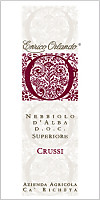
|
|
Nebbiolo d'Alba Superiore Crussi 2013 |
|
| Ca' Richeta (Piedmont, Italy) | |
 Nebbiolo Nebbiolo | |
| Price: € 12.20 | Score: |
 Brilliant ruby red and nuances of garnet red, moderate transparency. Brilliant ruby red and nuances of garnet red, moderate transparency. Intense, clean, pleasing and refined, starts with hints of cherry, plum
and violet followed by aromas of raspberry, rose, vanilla, tobacco,
chocolate and mace. Intense, clean, pleasing and refined, starts with hints of cherry, plum
and violet followed by aromas of raspberry, rose, vanilla, tobacco,
chocolate and mace.
 Properly tannic attack and however balanced by alcohol, good body,
intense flavors, pleasing crispness. Properly tannic attack and however balanced by alcohol, good body,
intense flavors, pleasing crispness.
 Persistent finish with flavors of cherry, plum and raspberry. Persistent finish with flavors of cherry, plum and raspberry. 24 months in cask, 6 months in bottle. 24 months in cask, 6 months in bottle. |
|
 Pasta with meat and mushrooms, Broiled meat and barbecue, Roasted meat Pasta with meat and mushrooms, Broiled meat and barbecue, Roasted meat |
|

|
|
Vino da Messa 2006 |
|
| Ca' Richeta (Piedmont, Italy) | |
 Moscato bianco, Sauvignon Blanc, Other Grapes Moscato bianco, Sauvignon Blanc, Other Grapes | |
| Price: € 14.50 - 375ml | Score: |
 Intense amber yellow and nuances of amber yellow, transparent. Intense amber yellow and nuances of amber yellow, transparent. Intense, clean, pleasing and refined, starts with hints of raisin,
dried fig and honey followed by aromas of dried apricot, peach jam, quince
jam, candied fruits, date, almond, vanilla and nail polish. Intense, clean, pleasing and refined, starts with hints of raisin,
dried fig and honey followed by aromas of dried apricot, peach jam, quince
jam, candied fruits, date, almond, vanilla and nail polish.
 Sweet attack and pleasing roundness, however balanced by alcohol, good
body, intense flavors, pleasing crispness. Sweet attack and pleasing roundness, however balanced by alcohol, good
body, intense flavors, pleasing crispness.
 Persistent finish with flavors of raisin, dried fig and honey. Persistent finish with flavors of raisin, dried fig and honey. 48 months in barrique. 48 months in barrique. |
|
 Hard cheese, Dried fruit desserts Hard cheese, Dried fruit desserts |
|
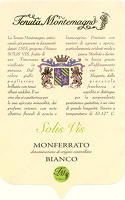
|
|
Monferrato Bianco Solis Vis 2014 |
|
| Tenuta Montemagno (Piedmont, Italy) | |
 Timorasso Timorasso | |
| Price: € 11.00 | Score: |
 Brilliant straw yellow and nuances of greenish yellow, very
transparent. Brilliant straw yellow and nuances of greenish yellow, very
transparent.
 Intense, clean, pleasing and refined, starts with hints of apple,
citrus fruits and pear followed by aromas of hazelnut, honey, plum, peach,
hawthorn, pineapple and broom. Intense, clean, pleasing and refined, starts with hints of apple,
citrus fruits and pear followed by aromas of hazelnut, honey, plum, peach,
hawthorn, pineapple and broom.
 Crisp attack and however balanced by alcohol, good body, intense
flavors, pleasing roundness. Crisp attack and however balanced by alcohol, good body, intense
flavors, pleasing roundness.
 Persistent finish with flavors of apple, plum and hazelnut. Persistent finish with flavors of apple, plum and hazelnut. Aged in steel tanks. Aged in steel tanks. |
|
 Stuffed pasta, Broiled white meat, Broiled fish, Roasted fish Stuffed pasta, Broiled white meat, Broiled fish, Roasted fish |
|
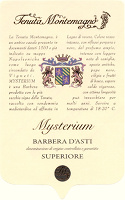
|
|
Barbera d'Asti Superiore Mysterium 2013 |
|
| Tenuta Montemagno (Piedmont, Italy) | |
 Berbera Berbera | |
| Price: € 15.00 | Score: |
 Brilliant ruby red and nuances of garnet red, moderate transparency. Brilliant ruby red and nuances of garnet red, moderate transparency. Intense, clean, pleasing and refined, starts with hints of cherry,
blueberry and plum followed by aromas of violet, raspberry, blackberry,
vanilla, chocolate, tobacco and menthol. Intense, clean, pleasing and refined, starts with hints of cherry,
blueberry and plum followed by aromas of violet, raspberry, blackberry,
vanilla, chocolate, tobacco and menthol.
 Properly tannic attack and however balanced by alcohol, good body,
intense flavors, agreeable. Properly tannic attack and however balanced by alcohol, good body,
intense flavors, agreeable.
 Persistent finish with flavors of cherry, blueberry and plum. Persistent finish with flavors of cherry, blueberry and plum. 12 months in cask and barrique. 12 months in cask and barrique. |
|
 Broiled meat and barbecue, Roasted meat, Stewed meat with mushrooms Broiled meat and barbecue, Roasted meat, Stewed meat with mushrooms |
|
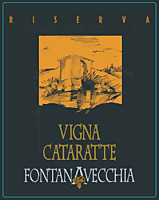
|
|
Aglianico del Taburno Riserva Vigna Cataratte 2008 |
|
| Fontanavecchia (Campania, Italy) | |
 Aglianico Aglianico | |
| Price: € 16.00 | Score: |
 Brilliant ruby red and nuances of garnet red, little transparency. Brilliant ruby red and nuances of garnet red, little transparency. Intense, clean, pleasing, refined and elegant, starts with hints of
plum, black cherry and blackberry followed by aromas of dried violet,
blueberry, tobacco, vanilla, cocoa, clover, cinnamon, leather, mace and
menthol. Intense, clean, pleasing, refined and elegant, starts with hints of
plum, black cherry and blackberry followed by aromas of dried violet,
blueberry, tobacco, vanilla, cocoa, clover, cinnamon, leather, mace and
menthol.
 Properly tannic attack and however balanced by alcohol, full body,
intense flavors, agreeable. Properly tannic attack and however balanced by alcohol, full body,
intense flavors, agreeable.
 Persistent finish with flavors of plum, black cherry and blackberry. Persistent finish with flavors of plum, black cherry and blackberry. 14 months in barrique. 14 months in barrique. |
|
 Game, Roasted meat, Stewed and braised meat, Hard cheese Game, Roasted meat, Stewed and braised meat, Hard cheese |
|
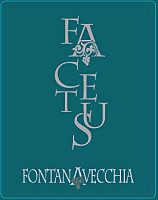
|
|
Taburno Falanghina Facetus 2008 |
|
| Fontanavecchia (Campania, Italy) | |
 Falanghina Falanghina | |
| Price: € 12.00 | Score: |
 Deep golden yellow and nuances of golden yellow, very transparent. Deep golden yellow and nuances of golden yellow, very transparent. Intense, clean, pleasing, refined and elegant, starts with hints of
ripe apple, citrus fruit peel and hazelnut followed by aromas of honey,
plum, dried apricot, quince jam, pear jam, vanilla, praline, peach jam,
hawthorn and mineral. Intense, clean, pleasing, refined and elegant, starts with hints of
ripe apple, citrus fruit peel and hazelnut followed by aromas of honey,
plum, dried apricot, quince jam, pear jam, vanilla, praline, peach jam,
hawthorn and mineral.
 Crisp attack and however balanced by alcohol, full body, intense
flavors, pleasing roundness. Crisp attack and however balanced by alcohol, full body, intense
flavors, pleasing roundness.
 Very persistent finish with long flavors of ripe apple, dried apricot
and hazelnut. Very persistent finish with long flavors of ripe apple, dried apricot
and hazelnut.
 9 months in barrique. 9 months in barrique. |
|
 Roasted white meat, Broiled meat, Roasted fish, Hard cheese Roasted white meat, Broiled meat, Roasted fish, Hard cheese |
|
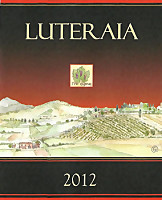
|
|
Luteraia 2012 |
|
| Luteraia (Tuscany, Italy) | |
 Sangiovese (70%), Canaiolo Nero (20%), Mammolo, Malvasia Aromatica Bianca (10%) Sangiovese (70%), Canaiolo Nero (20%), Mammolo, Malvasia Aromatica Bianca (10%) | |
| Price: € 13.00 | Score: |
 Brilliant ruby red and nuances of garnet red, moderate transparency. Brilliant ruby red and nuances of garnet red, moderate transparency. Intense, clean, pleasing and refined, starts with hints of black
cherry, plum and dried violet followed by aromas of blueberry, tobacco,
vanilla, chocolate, leather, mace, cinnamon and menthol. Intense, clean, pleasing and refined, starts with hints of black
cherry, plum and dried violet followed by aromas of blueberry, tobacco,
vanilla, chocolate, leather, mace, cinnamon and menthol.
 Properly tannic attack and however balanced by alcohol, full body,
intense flavors, agreeable. Properly tannic attack and however balanced by alcohol, full body,
intense flavors, agreeable.
 Persistent finish with flavors of plum, black cherry and blueberry. Persistent finish with flavors of plum, black cherry and blueberry. 12 months in cask, 24 months in bottle. 12 months in cask, 24 months in bottle. |
|
 Game, Roasted meat, Stewed and braised meat, Hard cheese Game, Roasted meat, Stewed and braised meat, Hard cheese |
|
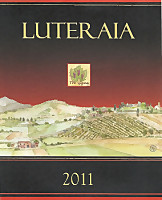
|
|
Vino Nobile di Montepulciano 2011 |
|
| Luteraia (Tuscany, Italy) | |
 Sangiovese (70%), Canaiolo Nero (20%), Mammolo, Malvasia Aromatica Bianca (10%) Sangiovese (70%), Canaiolo Nero (20%), Mammolo, Malvasia Aromatica Bianca (10%) | |
| Price: € 13.00 | Score: |
 Brilliant ruby red and nuances of brick red, moderate transparency. Brilliant ruby red and nuances of brick red, moderate transparency. Intense, clean, pleasing, refined and elegant, starts with hints of
plum, black cherry and dried violet followed by aromas of blueberry,
chocolate, vanilla, tobacco, mace, leather, mace and menthol. Intense, clean, pleasing, refined and elegant, starts with hints of
plum, black cherry and dried violet followed by aromas of blueberry,
chocolate, vanilla, tobacco, mace, leather, mace and menthol.
 Tannic attack and however balanced by alcohol, full body, intense
flavors, agreeable. Tannic attack and however balanced by alcohol, full body, intense
flavors, agreeable.
 Persistent finish with flavors of plum, black cherry and blueberry. Persistent finish with flavors of plum, black cherry and blueberry. 12 months in cask, 24 months in bottle. 12 months in cask, 24 months in bottle. |
|
 Game, Roasted meat, Stewed and braised meat, Hard cheese Game, Roasted meat, Stewed and braised meat, Hard cheese |
|
News |
|
In this section are published news and information about events concerning the world of wine and food. Whoever is interested in publishing this kind of information can send us a mail to our address.
|
AquavitaeReview of Grappa, Distillates and Brandy |
|
|
||||||||||||||
Wine Guide ParadeFebruary 2016
|
| |||||||
Privacy Policy | |||||||


| Copyright © 2002-2024 Antonello Biancalana, DiWineTaste - All rights reserved |
| All rights reserved under international copyright conventions. No part of this publication and of this WEB site may be
reproduced or utilized in any form or by any means, electronic or mechanical, without permission in writing from DiWineTaste. |